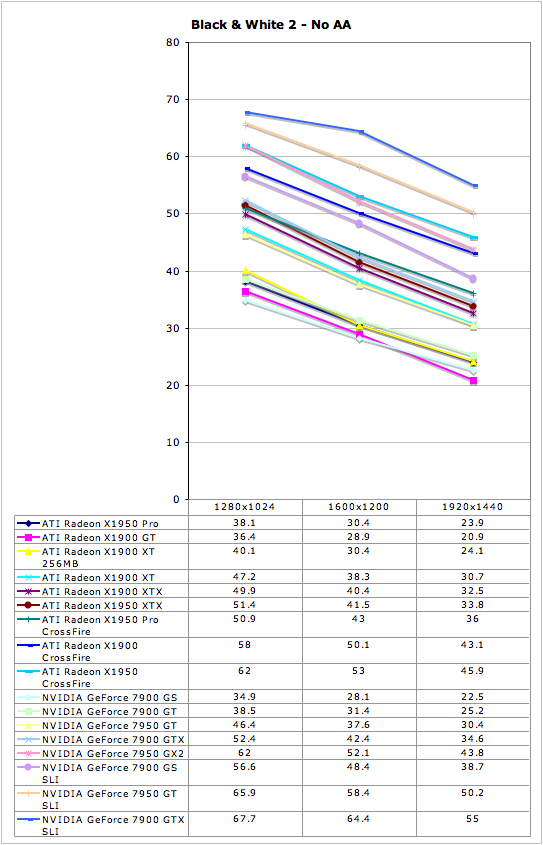ATI Radeon X1950 Pro: CrossFire Done Right
by Derek Wilson on October 17, 2006 6:22 AM EST- Posted in
- GPUs
Black & White 2 Performance
The AnandTech benchmark for Black & White 2 is a FRAPS benchmark. Between
the very first tutorial land and the second land there is a pretty well
rounded cut scene rendered in-game. This benchmark is indicative of real world
performance in Black & White 2. We are able to see many of the commonly
rendered objects in action. The most stressful part of the benchmark is a
scene where hundreds of soldiers come running over a hill, which really pounds
the geometry capabilities of these cards. At launch, ATI cards were severely
outmatched when it came to B&W2 performance because of this scene, but two
patches applied to the game and quite a few Catalyst revisions later give ATI
cards a much needed boost in performance over what we first saw.
A desirable average framerate for Black & White 2 is anything over 20 fps.
The game does remain playable down to the 17-19 fps range, but we usually
start seeing the occasional annoying hiccup during gameplay here. While this
isn't always a problem as far as getting things done and playing the game, any
jerkiness in frame rate degrades the overall experience.
We did test with all the options on the highest quality settings under the
custom menu. Antialiasing has quite a high performance hit in this game, and
is generally not worth it at high resolutions unless the game is running on a
super powerhouse of a graphics card. If you're the kind of person who just
must have AA enabled, you'll have to settle for a little bit lower resolution
than we tend to like on reasonably priced graphics cards. Black & White 2
is almost not worth playing at low resolutions without AA, depth of field, or
bloom enabled. At that point, we tend to get image quality that resembles the
original Black & White. While various people believe that the original was
a better game, no one doubts the superiority of B&W2's amazing
graphics.

As with Battlefield 2, we see performance on par with the 7900 GT. In this case, the X1950 Pro actually equals the performance of the X1900 XT 256MB. It seems like either geometry or memory (or both) are the major factors in performance here. Again, CrossFire offers a good boost over single card performance exceeding the high end single card solutions from both manufacturers, but 7900 GS SLI still comes back from behind in the singe card race to beat CrossFire.











45 Comments
View All Comments
DerekWilson - Tuesday, October 17, 2006 - link
First of all, every site uses their own benchmarking techniques and sequences in the games. Numbers between review sites won't be comparable.For Quake 4 we used ultraquality mode, and this seems to give ATI the advantage over NVIDIA. We don't have a problem with this because we would prefer to tip the scales in favor of the product that can deliver the best performance at the highest image quality.
munky - Tuesday, October 17, 2006 - link
Would you rather Ati continued to ship the x1900gt with the original specs, and then a bunch of the cards would have to be RMA'd?DerekWilson - Tuesday, October 17, 2006 - link
We would rather they just run out of x1900 GT cards. They're discontinuing the line anyways, so it seems a little strange to try to increase supply by underhanded means.sri2000 - Tuesday, October 17, 2006 - link
They should ship it under a different model number. Call is the X1900 GTA or something like that (or some other alphabet soup combo that's not already taken) so that people can tell that the different model# = different performance.Goty - Tuesday, October 17, 2006 - link
You guys are ragging on this CF implementation like it's some sub-par solution. The transfer speed may be lower than that used by NVIDIA's SLI bridge, but SLI is simplex while this implementation is full duplex. Being able to send data in both directions at the same time should provide a huge speed boost while using ATi's SuperAA modes.JarredWalton - Tuesday, October 17, 2006 - link
Scalability is the key factory. In most benchmarks, SLI gets more of an improvement than CrossFire, indicating that the compositing engine is not an optimal multi-GPU solution. There's almost certainly a decent amount of overhead involved. We do like the new CF connector, but the proof is in the pudding. If 7900 GS is clearly slower in single card configs but often faster in dual-GPU configs, clearly SLI is scaling better than CF.mesyn191 - Friday, October 20, 2006 - link
I don't think its possible to comment on the new CF at all, they've clearly got screwed up drivers for it ATM, but then its ATi so what else is new...I hope AMD cleans up thier driver team because still even after all these years ATi does a half assed job on its drivers.
Goty - Tuesday, October 17, 2006 - link
Are you guys thinking of doing any testing with any of either vendor's multi-card AA modes any time soon? I really think the full duplex connection would really help there (i.e. the cards may not scale as well with the number of cards, but what about as the image quality increases?)Rza79 - Tuesday, October 17, 2006 - link
The Tech Report had problems with this motherboard and Crossfire which made them switch to the Asus P5W DH.You aren't expiriencing any problems with this board?
Second thing, why no AA with games like B&W2 and FEAR?
DerekWilson - Tuesday, October 17, 2006 - link
No problems with the motherboard.AA performance under Black and White 2 and FEAR were excluded because we decided framerate was already at a minimum for the resolution we were testing.